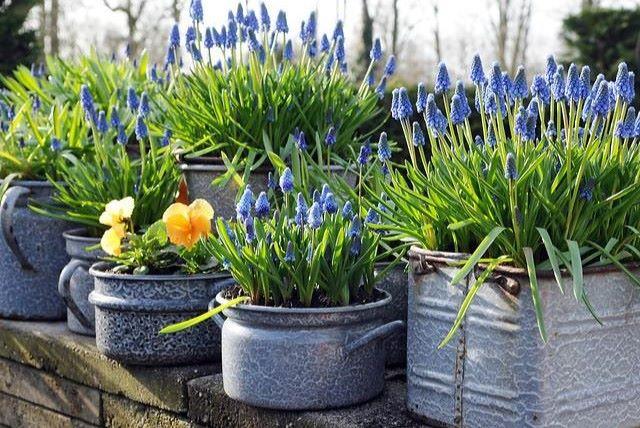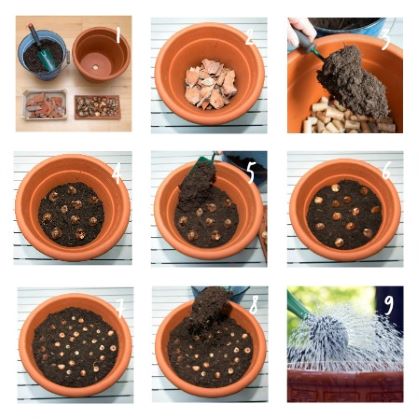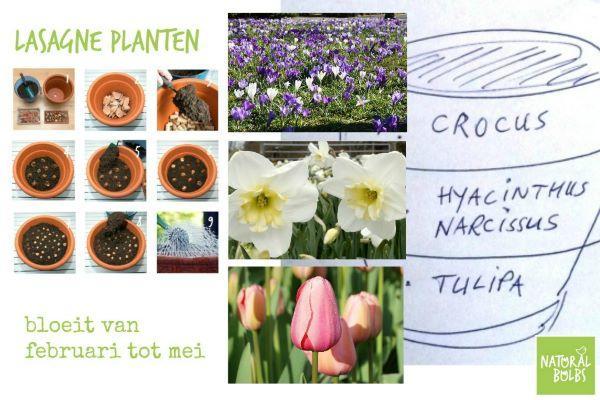Pots and baskets
Select a large container and fill it with a gorgeous combination of flower bulbs!
Bulbs are great for planting in containers or smaller pots. Best is to choose varieties that are winterhardy.
If you only use the bulbs for one year, they don't demand much from the soil. You could very well use pre-used potting soil from annuals. Also you can place the bulbs closer to eachother.
Always provide good drainage
If not, water will stand in the containers and the bulbs and their roots will rot.
Repeat for several years?
In that case, they must be planted in well-drained soil with ample compost and more spacing.
Planting in layers - LASAGNA
Of course you would like a prolonged flowering season. With bulbs you can plant in layers. Plant later flowering varieties in the bottom layer (i.e.Tulips), then add soil and on top place mid-season flowering bulbs (i.e. Daffodils and Hyacinths) and then top it off with more soil and early spring flowering bulbs (i.e. Crocus, Snowbells etc).
The steps are really simple. Follow these easy instructions:
1. and 2. Use a pot with a hole for drainage and toss in a layer of old wine corks or broken terracotta pot shards.
3. Add the first layer of soil.
4. Place the bottom layer of late-flowering bulbs (Tulips, Allium).
5. and 6. Add soil and plant the middle layer with middle-flowering bulbs (Daffodils, Hyacinths).
7. Add more soil and place a top layer of early-spring flowering bulbs (Crokus, Snowbells etc).
8. Top up with soil and if desired plant winterviolas on top or toss in a bunch of pine cones (frost protection).
9. Water moderately during winter.
Which varieties are suitable?
Use the product filters to create your own Lasagna:
Top layer
Plant early-spring-flowering varieties i.e. Crocus, Chionodoxa, Scilla.
Middle layer
Plant mid-spring-flowering varieties i.e. Daffodils, Hyacinths, Muscari.
Bottom layer
Plant late-spring-flowering varieties i.e. tall Tulips, tall Allium, Camassia.
Or why not make it fun and easy - just order this collection:
Lasagna Cool Colours
This collection contains bulbs that are co-ordinated to flower from february into may.
Fun to make and to share as a gift with friends. Click here to read further and how to obtain it.
If you prefer to re-use flower bulbs next year, this method is less suitable!
Spring-flowering bulbs in pots outdoors
The cold is not a problem for spring-flowering bulbs. So they can simply stay in a pot outside in winter. This is because flower bulbs can protect themselves. They convert the starch in the bulb into sugars. This increases the freezing point. However, it is important that the pot size is sufficient. At least a layer of 3x the size of the flower bulb above and below the bulbs. It is also important to have a hole in the pot to let excess water flow out. Cover the bottom with old potsherds, hydro grains or gravel for even better drainage. The bulbs can be planted up to 1 bulb thickness apart. After planting, press firmly and water generously. Even in January and February, they can still use some water in dry weather.
Then you have the summer-flowering bulbs and tubers. These only go into the ground in spring after the period of frost (Ice Saints), i.e. around the end of April to the end of May. This is because these bulbs are very sensitive to frost. Think of gladioli, callas and the beautiful dahlias. This rule applies in all cases: the earlier you plant them during this period, the earlier they will flower. As big as the bulb is, this is how deep you plant the bulbs or tubers in the ground. Always make a generous planting hole first with a bulb awl or shovel. Immediately after planting, give the bulbs plenty of water and keep the soil moist. Especially the dahlias need a lot of water throughout the summer.
Winter
The soil in a pot will suffer from frost more so than the soil in your yard where only the first few inches will freeze solid. When the winter forecast is for heavy frosts, it is best to move the pot indoors or wrap with straw and a plastic bag. Certainly when standing on a balcony, we suggest to be extra careful. Avoid a variety such as Daffodil Tête à Tête.








